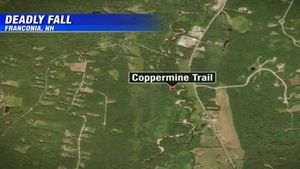Storm Bert unleashed its fury across southern England and Wales this past weekend, stirring chaos and destruction as heavy rain and high winds pummeled the region. Many towns were left reeling with damage to homes, businesses, and public infrastructure, leading to widespread clean-up efforts.
Hampshire, Dorset, Wiltshire, Gloucestershire, and South Gloucestershire experienced the brunt of the storm's impact. Roads were submerged, debris littered the streets, and floodwaters surged, forcing residents to flee their homes. The aftermath saw intense activity, with hundreds of emergency crews working tirelessly to assist affected individuals and restore services.
According to the latest reports from the Environment Agency, as many as 132 flood warnings had been issued by late Sunday, indicating serious danger to life due to rising water levels. The River Taff swelled catastrophically outside its banks, and residents of Billing Aquadrome Holiday Park had to seek refuge at evacuation centers as their homes were submerged.
Among the hardest-hit areas, the riverside towns found themselves under water as rainfall totals reached unprecedented levels. For example, the water level of the River Avon, which flows through Bradford-on-Avon, marked the highest ever recorded, surpassing all previous floods, including the notorious December 2013 deluge.
Local authorities set up emergency rest centers for displaced residents, particularly those living close to swollen rivers. Emergency services, including the Dorset & Wiltshire Fire and Rescue Service, reported numerous rescues from hazardous flood zones. One such rescue operation included 12 individuals and their pets from the Iford Bridge Home Park, highlighting the urgent pleas for help from within the community.
“It’s been devastating for this town,” stated Jack Vittles, mayor of Bradford-on-Avon, as the region faced the calamity. His comments echoed the sentiments of many as they witnessed their businesses and homes ravaged by floodwaters.
The public outcry over the effectiveness of flood defenses was palpable as residents took to social media and local gatherings to express their frustrations. Numerous local leaders called upon the government to take more substantial action to mitigate against future flooding events, noting the repetition of calamities without proper preventive measures being implemented.
Meanwhile, one astonishing story emerged amid the devastation. Caralyn Moreton, affectionately known as Mini, took swift action during the storm to protect her neighbors by securing floodgates and alerting others to the impending danger. Her brave efforts earned her the status of local hero as fellow residents appreciated her relentless drive to assist during the crisis, all the more poignant considering the absence of timely responses from official agencies.
With reports of injuries and at least five fatalities attributed to Storm Bert, the urgency to restore normalcy grew. Roads remained closed and rail services disrupted due to high water levels. Great Western Railway announced cancellations on several routes, advising travelers to complete their journeys before rain resumed late Monday.
Heavy downpours increased anxiety across the regions as more rain was predicted. Environment Secretary Steve Reed provided some reassurance, stating, “We anticipate the situation should be less severe as the rains continue to taper off.” This optimism did little to quell concerns, especially among those already dealing with the aftermath.
Further compounding the struggle, many small businesses faced significant challenges. One business owner, Gary Hatto, reflected on the extensive damage to his barbershop, recalling how furniture floated “like a scene from the Titanic.” With electricity outages and stock losses becoming the norm, local entrepreneurs found resources thin and spirits low.
Local governments and emergency agencies urged the public to remain vigilant and informed. “Flood warnings are serious. We need communities to be prepared and to act swiftly,” said Ian Withers from the Environment Agency, emphasizing the need for flood preparedness as climate conditions continue to worsen.
Looking forward, officials weather agencies are now scrambling to assess the impact and strategize for immediate recovery. More rain may be expected, and the challenges of the upcoming months linger ominously, marking yet another thawing winter for the community as it rebuilds.
The outpouring of community support following the storm showcased the resilience of residents as they organized food drives and offered aid to neighbors. Yet, the discussions of climate change and the responsibilities of local authorities remain hot topics of conversation as the country moves forward from the destructive weekend.
Emergency services continue to assess and recover efforts as floodwaters recede, but there is no denying the psychological and emotional toll this storm has taken on the communities. Many residents still face uncertainty about insurance claims, the future of their homes, and how to rebuild what was lost.
All eyes are on how local and national government responses evolve post-Storm Bert, as the affected regions await assurance of more effective flood management strategies to combat the increasingly severe weather patterns caused by climate change.
Memories of the flooding may fade with time, but for those now displaced and for businesses trying to restore operations, the effects will be felt long after the waters have receded.



